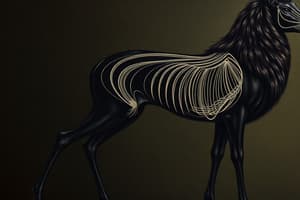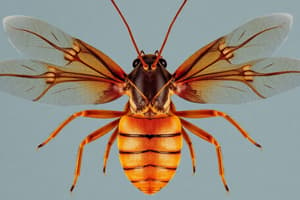Podcast
Questions and Answers
How does the surface area-to-volume ratio constrain cell size?
How does the surface area-to-volume ratio constrain cell size?
- As cells enlarge, the surface area decreases while the volume increases, promoting heat retention.
- As cells enlarge, the volume increases at a faster rate than the surface area, limiting nutrient diffusion. (correct)
- As cells enlarge, both surface area and volume increase proportionally, preventing cell specialization.
- As cells enlarge, the surface area increases at a faster rate than the volume, causing cells to divide.
How do larger multicellular organisms solve the limitations imposed by surface area-to-volume ratio?
How do larger multicellular organisms solve the limitations imposed by surface area-to-volume ratio?
- By relying solely on diffusion across their outer membrane for nutrient uptake.
- By developing specialized cells, organs, and organ systems to transport nutrients and oxygen. (correct)
- By evolving larger individual cells with increased metabolic efficiency.
- By decreasing their overall metabolic rate to reduce nutrient demand.
What is the key distinction between Parazoa and Eumetazoa in terms of tissue organization?
What is the key distinction between Parazoa and Eumetazoa in terms of tissue organization?
- Parazoa lack defined tissues and organs, whereas Eumetazoa have distinct tissues with irreversible cell differentiation. (correct)
- Eumetazoa can disaggregate and reaggregate their cells, whereas Parazoa exhibit irreversible cell differentiation.
- Eumetazoa exhibit specialized cell types but cannot aggregate into functional tissues, unlike Parazoa.
- Parazoa have well-defined tissues and organs, while Eumetazoa lack distinct tissue layers.
What is the primary role of connective tissues in the animal body?
What is the primary role of connective tissues in the animal body?
How does the structure of connective tissue contribute to its function?
How does the structure of connective tissue contribute to its function?
How do endothermic animals maintain their body temperature in cold environments, relative to their size?
How do endothermic animals maintain their body temperature in cold environments, relative to their size?
What adaptation would be most beneficial for an animal living in a very cold environment?
What adaptation would be most beneficial for an animal living in a very cold environment?
How does acclimatization assist an animal adjusting to a new environment?
How does acclimatization assist an animal adjusting to a new environment?
What is the fundamental difference between positive and negative feedback loops in maintaining homeostasis?
What is the fundamental difference between positive and negative feedback loops in maintaining homeostasis?
Which of the following illustrates a positive feedback mechanism?
Which of the following illustrates a positive feedback mechanism?
How does the hypothalamus contribute to thermoregulation in endotherms?
How does the hypothalamus contribute to thermoregulation in endotherms?
What is a key characteristic of animals with bilateral symmetry?
What is a key characteristic of animals with bilateral symmetry?
How does radial symmetry benefit aquatic animals like jellyfish?
How does radial symmetry benefit aquatic animals like jellyfish?
Which of the following best explains the purpose of a midsagittal plane?
Which of the following best explains the purpose of a midsagittal plane?
What type of tissue is responsible for generating movement in the animal body?
What type of tissue is responsible for generating movement in the animal body?
Which type of muscle tissue is characterized by involuntary control and the absence of striations?
Which type of muscle tissue is characterized by involuntary control and the absence of striations?
What is the primary function of nervous tissue?
What is the primary function of nervous tissue?
Which of the following is a key function of epithelial tissue?
Which of the following is a key function of epithelial tissue?
Why is maintaining a stable internal temperature crucial for animals?
Why is maintaining a stable internal temperature crucial for animals?
What distinguishes simple squamous epithelium from stratified squamous epithelium?
What distinguishes simple squamous epithelium from stratified squamous epithelium?
What is the role of fibroblasts in connective tissue?
What is the role of fibroblasts in connective tissue?
Where can loose/areolar connective tissue be found?
Where can loose/areolar connective tissue be found?
Which of the following examples is of cartilage connective tissue?
Which of the following examples is of cartilage connective tissue?
Which plane divides the body into dorsal and ventral portions?
Which plane divides the body into dorsal and ventral portions?
What is the main purpose of goblet cells found in simple columnar epithelium?
What is the main purpose of goblet cells found in simple columnar epithelium?
What are the main components of nervous tissue?
What are the main components of nervous tissue?
Which function is exclusive to cardiac muscle tissue?
Which function is exclusive to cardiac muscle tissue?
What is the metabolic consequence of smaller endothermic organisms having a higher BMR than larger ones?
What is the metabolic consequence of smaller endothermic organisms having a higher BMR than larger ones?
What are the different ways heat can be exchanged?
What are the different ways heat can be exchanged?
Flashcards
Sponges Symmetry
Sponges Symmetry
Sponges lack any definite symmetry.
Eumetazoa Symmetry
Eumetazoa Symmetry
Animals (excluding sponges) possess symmetry defined along an imaginary axis.
Radial Symmetry
Radial Symmetry
Body parts arranged around a central axis.
Bilateral Symmetry
Bilateral Symmetry
Signup and view all the flashcards
Cell Size Constraints
Cell Size Constraints
Signup and view all the flashcards
Parazoa Tissues
Parazoa Tissues
Signup and view all the flashcards
Eumetazoa Tissues
Eumetazoa Tissues
Signup and view all the flashcards
Nutrient Energy Use
Nutrient Energy Use
Signup and view all the flashcards
Basal Metabolic Rate (BMR)
Basal Metabolic Rate (BMR)
Signup and view all the flashcards
Sagittal Plane
Sagittal Plane
Signup and view all the flashcards
Midsagittal Plane
Midsagittal Plane
Signup and view all the flashcards
Frontal (Coronal) Plane
Frontal (Coronal) Plane
Signup and view all the flashcards
Transverse Plane
Transverse Plane
Signup and view all the flashcards
Four Main Tissue Types
Four Main Tissue Types
Signup and view all the flashcards
Epithelial Tissues
Epithelial Tissues
Signup and view all the flashcards
Connective Tissues
Connective Tissues
Signup and view all the flashcards
Muscle Tissue
Muscle Tissue
Signup and view all the flashcards
Nervous Tissue
Nervous Tissue
Signup and view all the flashcards
Components of Connective Tissue
Components of Connective Tissue
Signup and view all the flashcards
Homeostasis
Homeostasis
Signup and view all the flashcards
Negative Feedback Loop
Negative Feedback Loop
Signup and view all the flashcards
Positive Feedback Loop
Positive Feedback Loop
Signup and view all the flashcards
Homeostatic Set Point
Homeostatic Set Point
Signup and view all the flashcards
Methods of Heat Exchange
Methods of Heat Exchange
Signup and view all the flashcards
Study Notes
Animal Body Plans
- Three key aspects of animal body plans include symmetry, bioenergetics/thermoregulation, and tissues.
Evolution of Symmetry
- Sponges lack definite symmetry.
- All other animals exhibit symmetry described as Eumetozoa.
- Eumetazoa symmetry is defined along an imaginary axis through the body.
- Radial and bilateral symmetry are the two main types of symmetry present.
Symmetry Descriptions
- Radial symmetry arranges body parts around a central axis and can be bisected into two equal halves in any 2-D plane.
- Bilateral symmetry features right and left halves as mirror images, and only the sagittal plane bisects the animal into two equal halves.
Body Shapes, Sizes, and Metabolism
- Small, unicellular organisms acquire nutrients through diffusion.
- Cell size is limited by the surface area-to-volume ratio.
- As cell size increases, the surface area-to-volume ratio decreases, which is not good.
- Larger organisms compensate by having more (multicellular) smaller cells rather than larger cells.
- Providing nutrients and oxygen to all cells necessitates specialized cells, organs, and organ systems.
Evolution of Tissues
- Parazoa (sponges) lack defined tissues and organs, but they can disaggregate and aggregate their cells.
- Eumetazoa has distinct and well-defined tissues with mostly irreversible cell type differentiation.
Bioenergetics
- Energy from nutrients fuels anabolic reactions.
- Basal Metabolic Rate (BMR) is the average amount of energy used in a non-active state.
- Excess energy is released as heat.
- Smaller endothermic organisms have a higher BMR than larger ones to compensate for the heat lost from their surface area.
- Active animals exhibit a higher BMR than less active ones.
Body Planes and Cavities
- The sagittal plane divides the body into right and left portions.
- The midsagittal plane divides the body into two equal right and left halves.
- The frontal (coronal) plane separates the front from the back.
- The transverse (horizontal) plane divides the animal into upper and lower portions, sometimes called a cross-section.
- An oblique plane is a transverse cut at an angle.
Multicellular Animal Tissues Types
- There are four main types of animal tissues: epithelia, connective, muscles, and neurons.
- Epithelia line cavities, open spaces, and surfaces.
- Connective tissues connect tissues and provides support.
- Muscles generate movement.
- Neurons generate and transmit electrical signals.
Epithelial Types
- Squamous epithelium can be simple or stratified.
- Cuboidal epithelium can also be simple.
Muscle Tissues Types and Properties
- Three muscle tissue types exist: skeletal, smooth, and cardiac.
- Skeletal muscle is voluntary and striated.
- Smooth muscle is involuntary with no striations.
- Cardiac muscle is involuntary, striated, and contains intercalated discs.
Nervous Tissue
- Nervous tissue consists of neurons and neuroglia.
- Nervous tissue will generate and transmit electrical impulses
Homeostasis and Thermoregulation
- Homeostasis maintains stable internal conditions around a set point.
- If conditions deviate from the set point, homeostatic mechanisms activate.
- A set point can change over time, however homeostasis will still respond to that point.
- Acclimatization occurs when changes in one organ system help maintain a set point in another.
Negative Feedback Loops
- These loops counteract internal changes, reversing the direction of change.
- Most biological systems operate on negative feedback, for example temperature, glucose, pH, and blood calcium.
Positive Feedback Loops
- These loops maintain and potentially strengthen the response to a stimulus.
- Not many biological systems are based on positive feedback.
- Oxytocin production is an example of positive feedback, and the birth of a human infant is a result of this.
Thermoregulation
- Animals must maintain a constant internal temperature for efficient enzyme function and to avoid denaturation.
- Thermoregulatory control is managed by the hypothalamus.
- Animals can be either Endotherms or Ectotherms
- Temperature is maintained through radiation, convection, conduction, and/or evaporation.
Studying That Suits You
Use AI to generate personalized quizzes and flashcards to suit your learning preferences.




